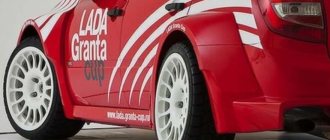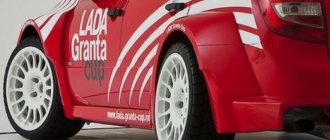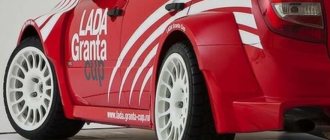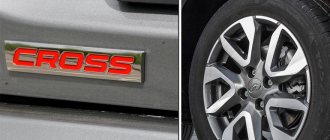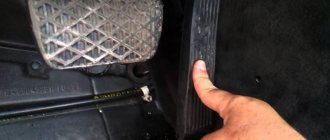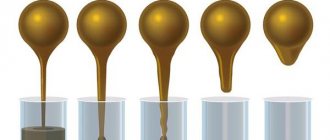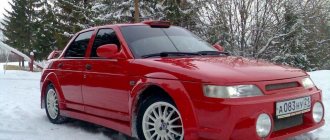Even the most avid Lada Vesta fan has to admit: the dynamics of this model are so-so. Especially if we are talking about a heavier station wagon, and even in the Cross version with larger wheels. Therefore, the topic of chip tuning is popular among newsmakers. Well, we took the opportunity to talk with owners of cars with 1.6 and 1.8 engines with Russian Racing Technology firmware, and also tried them out!
We did it according to the logs, then to the stand
And here’s how Vladimir himself describes this process on his social network page:
Upon arrival at the stand we had 111 hp. on the firmware, which was debugged on the road using logs. The work at the stand lasted about three hours, where the mixture was rolled out with the ShDC to the ideal in power mode, a lot of work was done with the ignition angle, and after 13-15 measurements we reached 115 hp. and 162 Nm. But it was too early to rush to conclusions; we decided to ride around 1000 km. The result after tuning at the stand on 10/06/2018: the car drove more than 1,200 km until 10/09/2018, a repeat measurement was made, where the numbers remained unchanged, which indicates that the torque model was correctly configured and that the solution can be used in series.”
"Spider" decides?
Heaven and earth
More recent Vestas with a 1.8-liter engine have received updated firmware in which these shortcomings are eliminated. If so, it would not interfere with early copies.
However, here is a gray car, purchased in the summer of 2022, it already has a new “square” ramp and what seems to be a new factory program. But even this car drove completely differently after reflashing!
At the stand, this particular car showed 137.2 hp. and 182.1 Nm (however, even before the firmware on the same stand, the car produced 136.2 hp and 175.5 Nm, which is higher than the factory values). And now the owners are already discussing with me the prospects of installing, say, an intake from a 145-horsepower Vesta Sport. Something tells me that in a year or two many interesting technical solutions will appear for the 1.8-liter engine...
I'm wondering if they are afraid of losing the warranty if the "chip" is discovered.
Our verdict
There are no miracles: without interfering with the hardware, you can’t squeeze much out of a naturally-aspirated engine through firmware alone. Nevertheless, in transitional modes the character of the engines has become more pleasant, this is especially noticeable in the 1.8-liter version, which, on the “alternative” firmware, is much more elastic in the low and medium speed zone. The 1.6-liter engine, although it has become subjectively “more fun,” still prefers to work at the “top”. As for replacing the standard catalytic collector with a “spider” one, taking into account the deterioration of environmental characteristics and acoustic comfort, this option is justified only in the case of building a serious tuning project or a sports car, where it is impossible to live without such a collector. But for everyday driving this is already too much.
| Factory data Lada Vesta SW Cross | |||
| Engine | 1.6-16v | 1.8-16v | |
| Working volume, cubic cm | 1596 | 1774 | |
| Power, kW (hp) at rpm | 78(106)/5800 | 90(122)/5900 | |
| Torque, Nm at rpm | 148/4200 | 170/3700 | |
| Transmission | 5M | 5M (5AMT) | |
| Acceleration 0-100 km/h, s | 12,6 | 11,2 (13,3) | |
| Maximum speed, km/h | 172 | 180 (181) | |
| Average fuel consumption, l | 7,5 | 7,9 (7,7) | |
| Dyno measurement results | ||||
| Engine | 1.6-16v | 1.6-16v (chip) | 1.8-16v | 1.8-16v (chip) |
| Power, kW (hp) at rpm | 79,1(107,7)/5931 | 84,7(115,2)/6256 | 100,1(136,2)/5901 | 100,8(137,2)/5979 |
| Torque, Nm at rpm | 145,2/4393 | 161,6/4098 | 175,5/4598 | 182,1/4581 |
Ivan KRISHKEVICH Photos of the author and car owners ABW.BY
More than 81,000 offers for the sale of new and used cars in our ad database.
Source
The main disappointment in the car: A motorist spoke about the problems with the 1.6 106 hp engine in the LADA Vesta
The VAZ engine is the anchor that prevents Vesta from becoming a modern car.
Photo: LADA Vesta 1.6, source: m.auto.ru
The main complaint about the 1.6-liter VAZ-21129 engine with a power of 106 horsepower, designed and assembled by AvtoVAZ, is its archaic nature. This opinion was shared by a motorist on the YouTube channel “LADA Vesta Blog” after 4 years of ownership. But even this LADA Vesta has its advantages.
Archaic and problematic “129th”
Because of this, car owners have to face a lot of problems:
New LADA Vesta FL 2021-2022: What is known about restyling today
LED optics, a tablet a la Tesla in the cabin and a more powerful engine - these are the innovations the updated Vesta will boast. The platform and overall design have not changed, but many cosmetic ones have appeared.
Among the advantages of the “anchor”, motorists note its reliability, provided that the oil, filters and timing kit are changed in a timely manner. The engine surprises with its service life, reaching 300-400 thousand km without capital. The maintainability, simplicity and low cost of servicing the unit is enviable.
The engine lends itself perfectly to “chipping” and boosting up to 130-150 “horses”, if you want to “experiment”.
Photo: Exterior, interior and engine of LADA Vesta 1.6 AMT, source: YouTube and LADA
However, the “newsman” noted that now, having experienced all the shortcomings of the “archaic” engine, he would take the Vesta with a 1.6-liter 113-horsepower unit from Renault paired with a CVT.
In addition, the constant “tugging” of the manual transmission lever is a thing of the last century; even the “blunting robot” is more progressive and provides more comfort than the “handle”.
Source
Lada Vesta jerks during acceleration, dips. There is a solution
Regardless of which engine is installed on the Lada Vesta, 1.6-liter (VAZ 21129) or 1.8-liter (VAZ 21179), each of them is controlled by electronic systems. Incorrect operation in transient modes, or more simply jerking, dips, jerks during start-up and acceleration, jerks when shifting gears can occur for various reasons. Fuel pressure is often not taken into account.
The theory of engine vibration at idle speed of Lada Vesta and possible causes
Theoretical aspects
The amount of air is regulated: the degree to which the gas pedal is pressed determines the opening angle of the throttle valve. Incorrect determination of the control system for the volume of the air mixture leads to the fact that the speed of the Lada Vesta floats at idle and while driving.
What causes the floating effect? The amount of gasoline sprayed into the manifold is calculated based on the volume of incoming air. When the computer perceives the latter incorrectly, the motor gains momentum. The degree of fuel injection remains the same, the mixture becomes leaner and the power plant begins to stall. The amount of oxygen and nitrogen mixture consumed is reduced, fuel consumption remains the same and is now sufficient - engine operation is stabilized. Then the cycle repeats.
Probable Causes
At this stage, it is clear that low-quality fuel can cause engine detonation, but not cause unstable idling. Untimely ignition of the fuel-air mixture can cause a negative effect. To eliminate the malfunction, a comprehensive inspection should be carried out:
- SU sensors.
- Regulator in the throttle assembly.
- Elements of the inlet assembly unit.
- Brake system units.
- Gasoline vapor recovery algorithm devices.
- Ignition systems.
Why does the Lada Vesta twitch, symptoms
Loss of power and even jerks when changing gears may well not be assessed very objectively. For example, with a manual transmission, an inept driver can shift in such a way that passengers feel overloads of 4g. But that's not what we're talking about now.
Failures in the operation of VAZ 21129 (1.6 l) and VAZ 21179 (1.8 l) cannot be called a generic disease, but the problem occurs quite often. However, symptoms of incorrect engine operation in transient modes can tell the mechanic a lot. And there are enough symptoms:
As you can see, there are enough symptoms and they are somewhat different, but the essence of the problem is the same - Vesta twitches, the engine runs rough.
Jerks, jerking of Lada Vesta and pressure in the fuel rail
Tired spark plugs, decrepit high-voltage wires, cracks in the corrugation of the intake manifold - all this can be checked and replaced simply. And immediately evaluate the result. However, in most cases, Lada Vesta owners complain that such manipulations are useless.
General diagram of the Lada Vesta fuel system. 1 – fuel rail; 2, 3, 4, 5 – fuel line; 6 – fuel module; 7 – gas tank.
The problem with VAZ engines 21129 and 21179 is insufficient pressure in the fuel rail . Here's the thing. Everyone knows that the path of gasoline from the gas tank to the cylinders looks like this:
In short, yes. We pay special attention to the second point of this list.
There are nuances here, since for a 1.8-liter engine the normal fuel pressure in the rail is 3.80 atm, and for a 1.6-liter engine it is 3.50 atm.
Cases have been observed where the wrong pressure regulators were installed from the factory in the fuel modules for both engines; the maximum that could be obtained from measurements was 3.60 atm in the ramp.
Naturally, with such pressure there is no way to talk about any correct work. And this is an even better option. In some cases, the pressure regulator made it possible to maintain only 2.7-2.85 atm at idle. Hence the dips and jerking when accelerating.
A pressure of 3.5 bar is generally considered normal, according to officials.
Engine oil burner 1.8
The VAZ 1.8 engine with a power of 122 hp took a long time to reach production cars. I was upset by three things: I turned out to be not so cheerful, I was hungry for gasoline and oil. Of course, oil loss is not on such a scale as on other turbo engines, but before Lad engines were not noticed in this way in principle, and therefore the topic has become acute.
Fuel consumption in traffic jams is good for 10 l/100 km, the owners of the West 1.8 just have to come to terms with it. But AVTOVAZ indirectly acknowledged two other problems by upgrading the engine. To improve traction characteristics, the firmware was changed. Maslozhor was eliminated by a whole range of modifications to the hardware and assembly process.
There seem to be fewer complaints, but evidence of increased consumption still occurs. Those who attended a long-term test in the editorial office of Vesta with a 1.8 engine also noted this.
How to increase the pressure in the fuel system of Lada Vesta to normal
If we are sure that the injectors are working correctly and they are clean, and the fuel pump is able to create the necessary pressure, then all the blame for the current situation with failures and jerking lies only with the pressure regulator. Here he is.
The hero of today's celebration is the fuel pressure regulator (FPR).
There are two options - either replace the pressure regulator with a new one at 3.8 atm, or improve the old one at your own risk. Oddly enough, the last option gives the best results.
First, let's buy a new regulator and install it in place. This is done simply, but not too quickly ( we figured out how to remove the Lada Vesta fuel module here ):
If the replacement did not give anything (the pressure in the ramp did not increase, it remained at 3.50 atm), we will try to modernize the old regulator.
The regulator has a very simple design - it is a valve in a housing, loaded by a spring with a calculated force. The spring must create such a force that the valve opens no earlier than the electric fuel pump creates a pressure of 3.80 bar.
The force of the spring on the valve is regulated by the depth of the recess in the lower part of the regulator.
The depth of the standard recess is about 3 mm.
To increase the force (thereby forcing the valve to open a little later and provide higher pressure), it is enough to carefully shrink the central part of the bottom of the regulator body by a few millimeters.
To do this, we use available tools - a long bolt with a rounded end on sandpaper, a strong washer of suitable diameter, a vice and a hammer. As a rule, the recess depth of a standard regulator is no more than 3 mm.
We install the RTD on a vice through a spacer made of a washer and with a light, precise blow we seat the bottom a few more millimeters.
Ready. You can check the results of modifications to the fuel pressure regulator by measuring the pressure in the rail or simply by going for a test drive.
In most cases, such a modification eliminates jerks during acceleration, allows you to save a little fuel (this can be seen by the instantaneous consumption on the BC display) and solves the problem with failures in transient engine operating modes and in maximum power modes.
Source
Adaptation of throttle valve zero on Vesta and XRay cars
Some buyers, after purchasing cars from the Lada Vesta and Xray family, encountered the problem of the car jerking when changing gears, as well as when starting to drive.
Some have managed to get used to the peculiarities of driving these cars, while others continue to experience similar problems. It is worth noting that such twitching was not noticed on all cars and the problem is not widespread. At first, there were no special solutions that could help eliminate the problem of cars jerking; commentators referred to the possible inexperience of drivers who had a problem and that was where the conversations ended. However, quite recently a small instruction has appeared that describes the procedure for adapting the throttle zero, after which, the majority of Xray car owners noted an improvement in acceleration stability and the disappearance of the twitching that was noticed earlier. Owners of cars of the Lada Vesta family also tried this procedure on their vehicles, but the results were not clear, some talked about positive changes, while others assured that nothing had changed at all.
If you are experiencing a problem with your Lada Vesta car jerking when starting to drive or changing gears, you should definitely try the procedure for adapting the throttle valve zero, especially since it is done without additional equipment, and the whole process takes only a few minutes.
Let's improve the characteristics of Lada Vesta
Do you want to enjoy the traction of your car? Is it frustrating that your car hesitates when you press the gas pedal? Not enough engine? Overclocking is frustrating? Is there something holding the car by the rear? Does the car jerk when changing gears? Not enough driving comfort? Do you want to spend less?
There is an effective solution for you. This solution is not for racing! It is for those who want to feel confident behind the wheel and enjoy driving.
The car moves due to engine speed and torque. I do it so that the torque increases traction at low speeds . Due to this, for example, acceleration dynamics increase , thoughtfulness disappears , or the effect when the engine roars but the car does not move. All the advantages are below.
Hello!
For the eleventh year , I have been mechanically removing dips and dullness from cars. Including the Lada Vesta, I increase power in the range from 1000 to 2500 engine speeds mechanically . The result of the mechanical modification can be seen in the video using the example of a Lada Vesta with engine 21129 1.6l.
In the video, the client shares his feelings about how his car drives after modifications.
* One-time service, for the entire life of the vehicle. Without interfering with the engine and electronics . No loss of warranty. A guarantee for the result is given.
Route map for identifying causes
Incorrect determination by the computer of the volume of air supplied to the combustion chamber, problems with the ignition system and an additional flow of gasoline vapor into the intake manifold of the Lada Vesta cause engine vibration at idle speed and operating modes. There are many reasons, so diagnosis should be done progressively. Check:
- Presence of air leaks in the intake pipe.
- The operation of the vacuum brake booster and the integrity of the connection between the tube and the input manifold.
- Canister valve.
- Throttle position sensors, absolute pressure and temperature sensors, idle air control.
- Integrity of wires and serviceability of ignition system coils.
I started seeing this problem. Sometimes there is a failure in power, that is, at FIRST you can’t turn it on until it slips (even with ESP turned off!), but if you turn off the engine and start it again, there is a possibility that the dynamics will return, the problem is floating and I don’t understand at all what it depends on. upd: I'm inclined to think that the pedal is being naughty.
upd: The switched-on speed limiter is to blame, it chokes the engine throughout the entire speed range, turn it off and everything is fine!
In order for the car to comply with more stringent environmental standards, AvtoVAZ equips modern Lada cars (Priora, Granta, Kalina, Niva, Largus, Vesta and XRAY) with an electronic gas pedal or “E-gas”. The throttle valve drive got rid of the cable and became equipped with a gear motor. As a result, the gas pedal has no mechanical connection with the throttle valve, and engine control has become completely electronic.
What is the technology
To increase power and reduce fuel consumption, using technology and license from Gadgetman Technologies, grooves of special geometry are mechanically made near the throttle valve, which changes the physics of air flow.
The car's throttle is precisely the component that prevents you from truly knowing how your car can actually drive! What is the throttle in a car? What is the throttle in a car?
In Russia, this technology is called MD-tuning. In the future “ Pro MD tuning ”. Pro MD tuning is professional tuning or modification of the car throttle. MD comes from the words modernization D Rossel .
Changes in air characteristics cannot in any way negatively affect the engine . But it perfectly increases engine power at low and medium speeds and reduces fuel consumption. And all this without interfering with the engine and electronics (ECU).
This technology allows for better mixing of gasoline and air vapors. Chip tuning cannot do this !
Drops of gasoline do not burn, but are thrown into the exhaust pipe. This is somewhere around 25-30% according to science. And this is 250-300 rubles. from every thousand spent on gasoline. Special grooves in the throttle valve create differences in air pressure and drops of gasoline turn into vapor. As a result, the fuel burns more completely. Therefore, our improvements pay for themselves
* The service is reversible . You are given time to “try it out” and a money back guarantee if you don’t like it. Modifying the throttle does not require additional intervention in the vehicle's ECU. The service is provided on the basis of a license agreement using special equipment.
The result of our work is expressed as follows:
In 90% of cases, the full effect does not appear immediately. You need to drive an average of 250 km for the ECU to retrain on a car with an injection engine. Therefore, a guarantee is given to return the unit to its original condition and return money if the result is not satisfactory. The disadvantages include changing the habit of pressing the gas pedal (accelerator). You will need to learn not to put too much pressure on the gas, since the car already drives fine, regardless of whether you press on the gas or not. Retraining takes from 15 minutes. As an example, look at how a regular Chevrolet Niva drives at idle.
* Refinement of the throttle does not require additional intervention in the vehicle's ECU. The service is provided on the basis of a license agreement using special equipment.
When fuel combustion improves, the car's power and traction at low speeds increases. Because more energy goes into work and torque in the range of 1000-3000 rpm.
What gives power at low speeds?
Sometimes the emotions of clients are like this (the first sensations and emotions on the Lada Largus 1.6l (internal combustion engine VAZ-21129) after the service in the video):
Jerks, dips of Lada Vesta and fuel pressure ⋆ I Love My Lada
Hi all!
I didn't plan to ever write anything on drive2, because... I use the car as a means of transportation, I’m not keen on modifications, but as usual, necessity forced me to do it. Therefore, I am writing in the hope of a collective mind that can help solve the problem.
Input data: Lada Vesta 2016, 1.6, robot AMT 1.0, stock engine firmware (factory): I765AG02.
And so to the essence of the problem.
With mileage (at the time of writing this article - 27 thousand km), the following problem began to appear more and more often and more clearly: when braking with the engine (the gas pedal does not
pressed) in 5,4,3,2 gears, when the engine speed drops close to idle, i.e. around 1200 rpm, the car starts kicking/jerking back and forth for 2-5 seconds, these jerks can be from 2 to approximately 8. As soon as you press the gas, or the robot disengages the clutch to engage a lower gear, the kicking/jerking goes away .
As many people have probably noticed, when the engine brakes, instantaneous fuel consumption drops to 0. This can be seen from the tidy readings. So, as far as I understand, the engine control program is written in such a way that shortly before the moment when the idle speed is reached and the AMT switches to a lower gear, the fuel supply is resumed so that at the time the speed is switched the engine does not stall and has already entered the operating mode with fuel supply. So, the moment the jerking/jerking begins always coincides with the moment when the fuel supply is resumed.
In order not to commit random actions, I decided to start with the diagnostic stage on my own. One person (thanks to geldor) advised me to drive a car with the OpenDiag Mobile program enabled in log recording mode for analysis, and then try to figure out the reason from the computer via DiagView. So I did. During the trip, we managed to achieve two pronounced moments of jerking/jerking. Next we will talk about their analysis ( Example #1
And
#2
).
Example #1:
On the graph, the tar interval is indicated by two vertical red lines. There are 5 seconds between them. During these 5 seconds, the revolutions dropped from 1325 to 1107. The speed was from 28 to 23. The graph of the engine speed (red) in this interval clearly shows that they are decreasing in jerks. At the same time, about a second before the start of the jerk, the fuel supply began (before this, engine braking took place without fuel supply), the throttle began to close. And what is most striking is that the moment the jerking begins coincides with the increase in the adsorber purge coefficient from zero. The clutch is engaged until the end of the jerk.
It would seem, well, here it is, the beginning of the jerking exactly coincides with the beginning of the increase in the “adsorber purging coefficient” indicator from zero, but example #2
makes me doubt this a little.
Example #2:
Here the picture is absolutely the same, the engine speed begins to “jump”, but they begin to do this for about a second even before the adsorber purge coefficient begins to increase from zero.
Example #1
gave me the idea to conduct a practical experiment - drive a car with the canister purge tube disconnected, and in one case leave the freed inlet fitting unplugged (there will be air leaks through the fitting), but in the second case, plug the fitting.
Who has any thoughts? Which way to “dig”? What is the problem and how to deal with it?
UPD 12/16/2019:
I plotted all the parameters to identify the correlation between the jumping engine speeds and them.
Full size
Example #2. Correlation of ECU parameters with jumping engine speeds
Result:
the most clearly floating
engine speeds
correlate with
SOP
, while
SOP
and
revolutions
at the moment of twitching are in antiphase.
There is a correlation with “relative air filling”
, also in antiphase, but slightly less pronounced.
There is also a noticeable correlation with fuel consumption
and
throttle position
.
Dear experts, attention to the question: which of the parameters jumping up and down is the exciting factor for the twitching back and forth that occurs?
UPD 12/17/2019:
I rode on a regular daily route to work and back, and before the trip I removed the tube from the solenoid valve for purge the adsorber in order to eliminate its influence on the specified problem. The hiss of air being sucked into the intake manifold was immediately heard from the tube.
On the road I didn’t notice any difference in the dynamics and behavior of the car. Fuel consumption at idle was also equal to the usual 0.7-0.9 according to the BC reading in the tidy. The car, as before, twitched a little when braking with the engine. But there is one place on the way home where there were almost always twitches, so much so that it was impossible not to notice them. The screenshots above are from exactly this place. Imagine my surprise when I didn’t feel any twitching during my first drive!
Full size
Example #3 (SHOCK! No twitching!)
Not believing what was happening, I made a U-turn and drove through this place again - the traffic returned.
Full size
Example #4 - jerk again
The result of the experiment
to disconnect the adsorber blower pipe: the adsorber has no effect on the problem, and the reason for the jerking is something else.
From the graphs we can conclude that jerking occurs when the OZ begins to jump up and down
.
If the OZ
is relatively “smooth”, then there are no twitches.
Several reviews on other cars
UAZ Patriot , 2.7 l., 2009 It became easy to move and accelerate. Especially for maneuverability. Became like a good foreign car. The car is unrecognizable, it rolls in such a way that it is not inferior to any foreign car. I like to ride. Alexander
The first impressions of car owners after the service on a UAZ Patriot.
Your browser does not support video. Please use another browser.
Good afternoon Vladislav. Today I received a parcel with a throttle and immediately installed the unit. The car is unrecognizable. The Volga , weighing 1.8 tons, tears from a stop with slipping through our mountains , where it used to go in 3-4 gears, now it is free in 5th and is still accelerating . At the old node the speed is 90 km. accelerated at 3000-3300rpm. Now 2000-2300rpm. It's fun to overtake, there's no need to switch to a lower gear . And at the same time I barely press the gas pedal. So far I'm very pleased with the result.
Sincerely, Valentin Borzov (Sevastopol)
The first sensations of the car owner after the service on the Mitsubishi Pajero-4 manual transmission 3l.
Your browser does not support video. Please use another browser.
Reviews on various forums
The throttle assembly has been modified. From service to home I really enjoyed the ride. No more pressing on the pedal. Just put your foot down and the car GOES. At the bottom he boldly undermines. The deep, blunt hole disappeared when the speed increased from 70 to 100 km/h. And consumption has dropped further, by 0.5 liters so far. Thank you so much for a job well done. Super. After modifications, the car actually DRIVES even with air conditioning!
Where do the savings come from?
A four-cylinder engine makes four strokes in one full cycle. On the first stroke, fuel is always supplied. A modified throttle makes the fuel mixture better. Due to which it burns better. Because of this, the engine torque increases. And the car becomes more dynamic at low speeds. After a short dynamic acceleration, switch to a higher gear. Due to this, the speed is reduced. And the number of first measures decreases. That is, less fuel is supplied. On some cars, the ECU also reduces the amount of fuel supplied.
Why does the new Lada Vesta accelerate poorly?
Owners of the new Lada Vesta may be unpleasantly surprised by its inexpressive dynamics - the car is frankly “stupid” during acceleration, even with a manual transmission. What is the reason for this, does it need to be treated? I'll tell you based on my own experience.
This article will focus on the Lada Vesta in the “Comfort” configuration, manual transmission, 1.6 liter engine.
The reasons for the sluggish acceleration of the new Vesta “from the bottom” are as follows:
1. On a new car, the engine has not yet “rolled out”. It gains full strength somewhere around 10-15 thousand kilometers. There's nothing you can do about it, you just need to be patient and not overload it unnecessarily, at least for the first 2000 kilometers - they are designated by the factory as a break-in period. During this period, I tried not to spin the engine above 3000 rpm.
2. After the first 2000 kilometers were covered, I began to periodically give higher revolutions and found out that at 3500-5000 rpm the thrust is quite normal. As practice has shown, the “top” engine is more convenient than the “low” one - in the city there is enough dynamics to keep in the flow (but no more), but if you need to overtake someone on the highway, we switch to a lower gear and get really brisk acceleration. With a low-end engine, overtaking is more difficult.
3. The West gearbox has more “stretched” gears than many foreign cars of comparable class. That is why the dynamics of the car are not so impressive. But there is also a positive point - the car is more economical than the same Logan or Almera.
4. Vesta’s weight is also greater than that of its competitors - the sedan weighs 1230 kg. Logan weighs 1106 kg, Almera - 1170 kg, Kia Rio - 1160 kg. That is, the difference approximately corresponds to the weight of the additional passenger. Naturally, this affects the acceleration dynamics.
5. Standard ECU firmware for Euro5 “strangles” the engine at low speeds. So that there is no desire to inject more fuel into the engine than it can burn and not pollute the environment with “low-quality” exhaust gases. Looks like they overdid it. However, this feature is characteristic of all modern cars without exception.
Another noticed feature (not only of Vesta!) is that in hot weather the car’s dynamics are worse than in cool weather. It's not even a matter of the air conditioner being on. The reason is that hot air is more rarefied than cold air. Accordingly, the oxygen content per unit volume is less. Oxygen is an oxidizing agent that causes the mixture to burn in the cylinders. To maintain dynamic performance in hot weather, the engine requires more air, but the throughput of the intake tract is limited, which can cause “oxygen starvation.” In response to this, the ECU reduces the amount of fuel injected. When driving slowly at low speeds, this effect is practically unnoticeable, but if you try to accelerate sharply, the reduction in traction will be very noticeable. Personally, I got my fill of this in July on the roads of the Krasnodar Territory in 33-degree heat, overtaking trucks.
Let's sum it up
When buying a Vesta, you should be aware that this is not a racing car or a city “lighter”. This is a car for calm travel from point A to point B.
The 1.6 engine in the new Vesta may indeed seem “dull”, but as it runs in it gains strength. The main thing is to maintain a sense of proportion and not overload the first few thousand kilometers with long driving at too low and too high speeds.
Questions and answers
How did you come up with this?
I didn't invent the technology. I'm just a copyright holder. And I bring the technology to mind.
How long have you been doing this?
This is my eleventh year of professionally improving the performance of cars using mechanical modifications of the throttle. I'm not deceiving anyone and I'm not running from anyone. Deceiving people is not my specialty, and deceiving is more expensive for myself. I guarantee my work. The described changes in cars are recorded from the words of customers.
What cars have throttle modifications done on them?
Modification of the throttle is done for gasoline (injection, carburetor) engines. We use other technologies for diesel engines.
How much will the engine power increase after modifying the throttle?
The engine produces maximum power at high speeds of 4000-7000 rpm, depending on the engine. This is the indicator that is written in your documents. At low and medium speeds the engine does not produce maximum power. Using this technology, I increase power at low speeds and partly at medium speeds. And this indicator does not in any way affect the maximum engine power. Therefore, the horses remain, and traction at low speeds increases.
How can modifications to the throttle affect engine life?
Positively! The less fuel is burned, the less soot and coking of pistons and piston rings is formed. The absence of carbon deposits does not lead to other ensuing problems with the engine. It also extends the life of the car’s catalyst, if it still has one. Because unburned gasoline does not burn out in the catalyst. After modifying the throttle, you start driving at lower speeds. Fewer revolutions reduce wear on engine rubbing parts. Thus, the motor life of the engine increases.
Why don't manufacturers immediately modify the throttle?
Why don’t manufacturers immediately do what the market offers to improve cars?!
Firstly, the technology is young. Secondly, the manufacturer puts into the car what the market offers. Bosch holds the lion's share of the electrical market. Therefore, this modification must be done by Bosch. Thirdly, there is information that this technology was bought by Toyota and BMW. It is possible that new car models from these manufacturers will already have this modification.
* You can see the rest of the answers to the questions at the link »» at the link »»
Service cost
Moscow and region
The service is provided on site or at the address: village. Fork, 2a . The village is located outside the Moscow Ring Road along Kashirskoye Highway opposite the state farm named after. Lenin. See further down the site for the service provision period.
Ask questions to the master by phone: 8-965-321-31-01 (Beeline Moscow).
Or write to the master by e-mail:
Or use the feedback form in the lower right corner. * Write your cell phone number directly in the message. Sometimes the answer doesn’t reach you!
St. Petersburg and region
The service is usually provided on site in your territory. Description of the terms of service further down the site.
Or by writing by e-mail:
Or use the feedback form in the lower right corner. * Write your cell phone number directly in the message. Sometimes the answer doesn’t reach you!
Cheboksary
See further on the site for the provision of services in Cheboksary
You can ask him questions by phone: 8-965-321-31-01 (Beeline Moscow) 8-965-070-65-01 (Beeline Peter) WhatsApp. I can call you back from this number.
Or write to the master by e-mail:
Or use the feedback form in the lower right corner. Please include your cell phone number in your message.
Nizhny Novgorod
See further on the site for the provision of services in Nizhny Novgorod
You can ask him questions by phone: 8-965-321-31-01 (Beeline Moscow) 8-965-070-65-01 (Beeline Peter) WhatsApp. I can call you back from this number.
Or write to the master by e-mail:
Or use the feedback form in the lower right corner. Please include your cell phone number in your message.
Naberezhnye Chelny
In Naberezhnye Chelny, the service will be provided upon arrival in the city. See the schedule further down the site.
You can ask questions by phone: 8-987-406-77-07 (MTS Nab. Chelny) 8-937-57-11-007 (Megafon Nab. Chelny)
Or write to the master by e-mail:
Or use the feedback form in the lower right corner. * Write your cell phone number directly in the message. Sometimes the answer doesn’t reach you!
Ekaterinburg
See further on the site for the provision of services in Yekaterinburg The place of stay will be Pervouralsk.
You can ask questions or leave a request using feedback by e-mail:
or by phone:
8-965-070-65-01 (Beeline Peter) WhatsApp.
I can call you back from this number. Or use the feedback form in the lower right corner.
Chelyabinsk
See further on the site for the provision of services in Chelyabinsk
You can ask him questions by phone: 8-965-321-31-01 (Beeline Moscow) 8-965-070-65-01 (Beeline Peter) WhatsApp. I can call you back from this number.
Or write to the master by e-mail:
Or use the feedback form in the lower right corner.
See further on the site for the provision of services in Ufa
You can ask him questions by phone: 8-965-321-31-01 (Beeline Moscow) 8-965-070-65-01 (Beeline Peter) WhatsApp. I can call you back from this number.
Or write to the master by e-mail:
Or use the feedback form in the lower right corner.
Samara
See further on the site for the provision of services in Samara
You can ask him questions by phone: 8-965-321-31-01 (Beeline Moscow) 8-965-070-65-01 (Beeline Peter) WhatsApp. I can call you back from this number.
Or write to the master by e-mail:
Or use the feedback form in the lower right corner.
See further on the site for the provision of services in Tula
You can ask him questions by phone: 8-965-321-31-01 (Beeline Moscow) 8-965-070-65-01 (Beeline Peter) WhatsApp. I can call you back from this number.
Or write to the master by e-mail:
Or use the feedback form in the lower right corner.
Voronezh
See further on the site for the provision of services in Voronezh
You can ask him questions by phone: 8-965-321-31-01 (Beeline Moscow) 8-965-070-65-01 (Beeline Peter) WhatsApp. I can call you back from this number.
Or write to the master by e-mail:
Or use the feedback form in the lower right corner.
Rostov-on-Don
See further on the site for the provision of services in Rostov
You can ask him questions by phone: 8-965-321-31-01 (Beeline Moscow) 8-965-070-65-01 (Beeline Peter) WhatsApp. I can call you back from this number.
Or write to the master by e-mail:
Or use the feedback form in the lower right corner.
Krasnodar
See further on the site for the provision of services in Krasnodar
You can ask me questions by phone: 8-965-321-31-01 (Beeline Moscow) 8-965-070-65-01 (Beeline St. Petersburg) WhatsApp. I can call you back from this number.
Or write to the master by e-mail:
Or use the feedback form in the lower right corner.
Novorossiysk
See further on the site for the provision of services in Novorossiysk
You can ask me questions by phone: 8-965-321-31-01 (Beeline Moscow) 8-965-070-65-01 (Beeline St. Petersburg) WhatsApp. I can call you back from this number.
Or write to the master by e-mail:
Or use the feedback form in the lower right corner.
Anapa
See further on the site for the provision of services in Anapa
You can ask me questions by phone: 8-965-321-31-01 (Beeline Moscow) 8-965-070-65-01 (Beeline St. Petersburg) WhatsApp. I can call you back from this number.
Or write to the master by e-mail:
Or use the feedback form in the lower right corner.
Penza
See further on the site for the provision of services in Penza
You can ask me questions by phone: 8-965-321-31-01 (Beeline Moscow) 8-965-070-65-01 (Beeline St. Petersburg) WhatsApp. I can call you back from this number.
Or write to the master by e-mail:
Or use the feedback form in the lower right corner.
Ulyanovsk
See further on the site for the provision of services in Ulyanovsk
You can ask him questions by phone: 8-965-321-31-01 (Beeline Moscow) 8-965-070-65-01 (Beeline Peter) WhatsApp. I can call you back from this number.
Or write to the master by e-mail:
Or use the feedback form in the lower right corner.
Tambov
See further on the site for the provision of services in Tambov
You can ask him questions by phone: 8-965-321-31-01 (Beeline Moscow) 8-965-070-65-01 (Beeline Peter) WhatsApp. I can call you back from this number.
Or write to the master by e-mail:
Or use the feedback form in the lower right corner.
Saratov
See further on the site for the provision of services in Saratov The place of stay will be Tatishchevo.
You can ask him questions by phone: 8-965-321-31-01 (Beeline Moscow) 8-965-070-65-01 (Beeline Peter) WhatsApp. I can call you back from this number.
Or write to the master by e-mail:
Or use the feedback form in the lower right corner.
Tolyatti
See further on the site for the provision of services in Tolyatti
You can ask me questions by phone: 8-965-321-31-01 (Beeline Moscow) 8-965-070-65-01 (Beeline St. Petersburg) WhatsApp. I can call you back from this number.
Or write to the master by e-mail:
Or use the feedback form in the lower right corner.
Terms of service
The knot itself can be removed anywhere. This can be done in the garage. But usually, the unit is removed near the client’s entrance. We remove the knot. Let's go home. Sharpening. We take it out, install it, check it. You don't have to drive across the city, stand in traffic jams, etc. You save a lot of time and nerves.
If you have the opportunity and your superiors, we can provide the service right at your place of work. You can drive home from work with pleasure from the way your car drives. The service can also be provided with travel to nearby settlements from the city, which can be reached by bus or train. In this case, transportation costs are added to the cost of the service. In any case, these expenses will cost you less than your arrival. You can save on transportation costs if you cooperate with someone and the service is provided to someone else besides you.
* To work you need a small table, chair and 220V.
And, of course, it is desirable that the car is clean. Or there was some kind of rag to cover the dirty fender of the car. It is also necessary to have a rag for washing the throttle.
For reference: sawdust does not fly all over the space. Metal filings don’t go anywhere beyond the newspaper.


